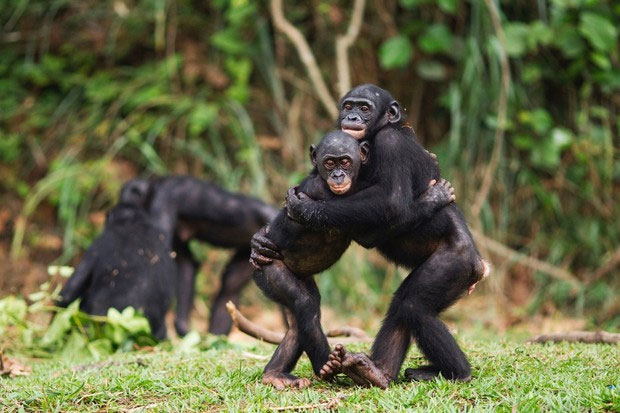The Covid-19 pandemic has disrupted one of the most familiar human actions: hugging. A hug provides a sense of reassurance, comfort, and calm.
Does hugging exist in the rest of the animal kingdom? A primate researcher in Africa notes that hugging is indeed common in the lives of primates.
Bonobos (Pan paniscus), the primate species that is the primary focus of Zanna Clay, a psychologist and primatologist at Durham University in the UK. Clay studies social interactions among bonobos, and most of her observational work takes place at a sanctuary in the Democratic Republic of Congo for bonobos whose lives have been disrupted by hunting. At this sanctuary, it is common to see infant primates clinging to each other as they move around together. Clay states: “Orphaned primates often hug each other, even while walking.”

Hugging seems to be a source of comfort in the face of danger.
This behavior may stem from the maternal instincts of female bonobos, who embrace their young when they are small. In many primate species, mothers hold their offspring tightly for extended periods during infancy. For example, chimpanzees (Pan troglodytes), close relatives of bonobos, are also known to hug and kiss each other frequently.
Clay says: “If they hear a predator, or another group of chimpanzees, or something frightening, that’s when you’ll see them touching each other and holding on tightly. Hugging seems to be a source of comfort in the face of danger.”
In the case of the black crested macaque (Macaca nigra), which lives in Indonesia, hugging comes with a more vibrant expression: These monkeys ask for hugs by raising their lips, an invitation not only for family but extending to other members of the troop.
Additionally, young orangutans have been observed rushing to hug each other when faced with the threat of a snake, thus highlighting the clear comforting role of hugging in times of stress or fear.
In another species, the Tonkean macaque (Macaca tonkeana), researchers have found that comforting hugs are common after a fight and can even be accompanied by a kiss.
According to Clay, a notable difference between human hugs and those of their primate relatives is that humans seem to imbue more social symbolism into the hug. In humans, a hug becomes a form of greeting or farewell, whereas monkeys and chimpanzees do not exhibit this tendency.
What About Other Species?
Hugging in primates is easily recognizable because it resembles human hugging, but other species may have their own forms of hugging, expressed differently.
Research on primates indicates that hugging serves functions of bonding, comforting, and creating peace, but similar behaviors may exist in other animal species. For example, horses groom each other, and studies show this activity reduces their heart rates—a sign of comfort and calm.
Researchers have observed that if a horse detects signs of distress in its partner, it will rush over and quickly start grooming its partner’s coat. This behavior has been interpreted as a comforting action. In birds, preening among pairs is thought to enhance social bonds.
Lions rubbing their heads against each other are believed to promote their social relationships. Hundreds of other mammal species rely on, snuggle, and huddle together for comfort and warmth, or to form a united front against danger—playing a role similar to the firm hugs we see in primates.
Meanwhile, dolphins appear to exhibit a type of comforting behavior by rubbing against or gently pulling each other underwater.



















































